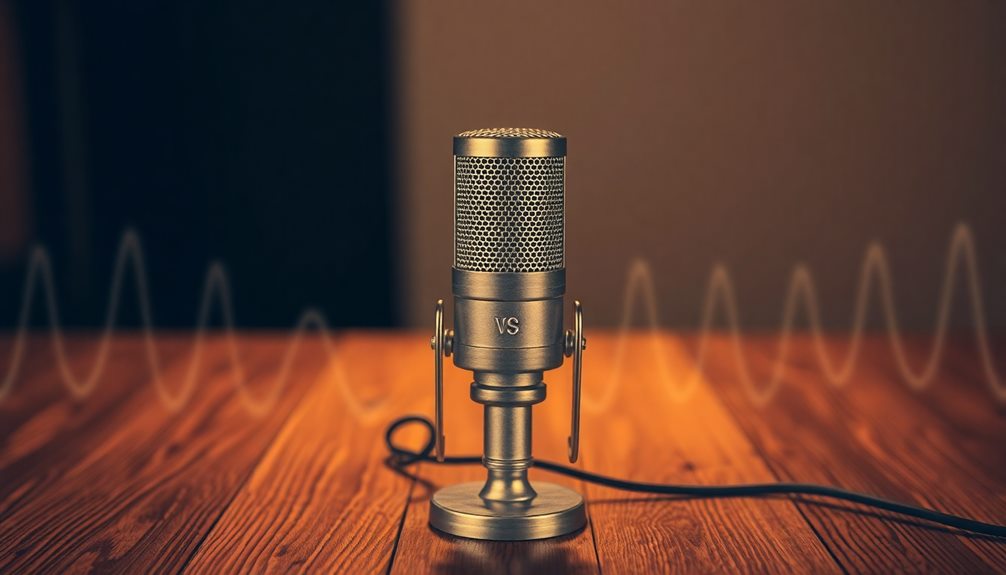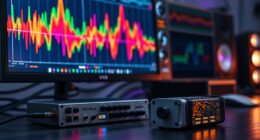Condenser microphones are amazing tools for capturing clear and vibrant sound! They're popular with musicians, podcasters, and voiceover artists because they catch tiny details that other mics might miss. You'll find two main types: large diaphragm mics, perfect for warm vocals, and small diaphragm mics, great for instruments. Most need phantom power to work properly, so make sure your setup can provide that. You can use them in studios, homes, or for filming. Want to know which models are best or how to place them for perfect sound? Keep exploring, and you'll find all the answers you need!
Key Takeaways
- Condenser microphones are highly sensitive, capturing subtle audio details with a frequency response of 20 Hz to 20 kHz, ideal for professional recording.
- They require phantom power (usually 48V) for operation, which enhances output signal clarity for recordings.
- Large diaphragm models are preferred for warm vocal performances, while small diaphragm models excel in capturing detailed instrument sounds.
- Key applications include studio recording, voiceovers, podcasting, and directional audio capture in film and broadcast.
- Popular models such as Rode NT1 and Audio-Technica AT2020 offer low self-noise and balanced sound for versatile recording needs.
Overview of Condenser Microphones
If you're diving into the world of audio recording, understanding condenser microphones is essential. These amazing devices are known for their high sensitivity and wide frequency response. They capture sound beautifully, making them a favorite for professional recording.
When you use a large diaphragm condenser microphone, you'll notice how it enhances vocal performance with warmth and detail. This is why they're often chosen for studio applications, like recording vocals or acoustic instruments.
Condenser microphones require phantom power, usually 48V, to operate. This external power helps them convert sound waves into electrical signals. One of their standout features is low self-noise, which means they can pick up even the tiniest sounds without adding unwanted noise. That's perfect when you want clear audio!
In a studio or controlled environment, these microphones shine. They're ideal for voiceovers, podcasting, and film production where you need high-fidelity sound.
However, their sensitivity makes them less suited for loud or noisy spaces. So, when you're ready to capture some incredible audio, consider using a condenser microphone to bring your recordings to life!
Types of Condenser Microphones

Now it's time to explore the different types of condenser microphones!
You'll find that the size of the diaphragm makes a big difference, with large ones perfect for capturing warm vocals and small ones great for clear instrument sounds.
Plus, there are specialized models like shotgun mics for focused recording and USB mics that plug right into your computer, making it easy to start recording.
Diaphragm Size Differences
When choosing a condenser microphone, understanding diaphragm size differences is essential for achieving the desired sound quality. The size of the diaphragm can make a big impact on how your recordings turn out.
Here's a quick look at the differences:
- Large diaphragm condensers are over 1 inch wide and are fantastic for recording vocals. They give a warm, rich sound that really brings your voice to life.
- Small diaphragm condensers are less than 0.5 inches wide. They've a flatter frequency response, perfect for capturing the nuances of instruments and high-frequency sounds.
- Tube condensers, known for their warmth, often use larger diaphragms. They can add lovely harmonics but may have a bit more self-noise.
- Shotgun microphones are specialized mics with a long pickup pattern. They're great for focused audio from a distance, making them ideal for film and broadcast.
Choosing between large and small diaphragm sizes depends on what you're recording. If you're focusing on vocal applications, go for large diaphragms! For instruments, small diaphragms shine.
Specialized Condenser Models
Understanding diaphragm size differences sets the stage for exploring specialized condenser models. These mics come in various types, each with unique features to suit your recording needs. Here's a quick look at some specialized condenser models:
| Type | Description |
|---|---|
| Large-Diaphragm Condenser | Perfect for recording vocals, providing a warm, rich sound in studios. |
| Small-Diaphragm Condensers | Ideal for capturing high frequencies and accurate details, especially for instruments. |
| Tube Condenser Microphones | Add warmth and harmonics to recordings, great for vocals but with higher self-noise. |
| USB Condenser Microphones | Simplify home recording with USB outputs and good sound quality. |
| Shotgun Microphones | Focused audio capture from a distance, making them perfect for film and location recording. |
When you use these mics, remember that the diaphragm moves in response to sound, capturing different polar patterns. Large-diaphragm condensers shine for recording vocals, while small-diaphragm condensers excel in high frequencies. If you're into home recording, USB condenser microphones offer a user-friendly option, while tube models bring that special warmth to your sound. Enjoy exploring these awesome tools!
Applications of Condenser Microphones

Condenser microphones are frequently the go-to choice for a variety of audio applications, thanks to their exceptional sensitivity and wide frequency response. They're perfect for capturing the magic in your recordings!
Here are some amazing ways you can use them:
- Studio Recording: Use them to capture stunning vocals and acoustic instruments, bringing out every nuance.
- Voiceover Work: They provide incredible clarity and warmth, making your narrations sound professional and engaging.
- Directional Audio Capture: Shotgun condenser mics are fantastic for film and broadcasting, isolating sound from the source while reducing background noise.
- Podcasting: Get that broadcast-quality sound! Condenser microphones enhance clarity and detail in your speech, making your podcasts enjoyable and easy to listen to.
Whether you're recording music, narrating stories, or creating engaging podcasts, condenser microphones are a reliable choice.
With small-diaphragm condensers, you can even capture the crisp sounds of drum overheads and brass instruments. Each application showcases their high sensitivity, making them a must-have tool for any audio enthusiast.
Immerse yourself in the world of sound with these versatile microphones!
Advantages of Condenser Microphones
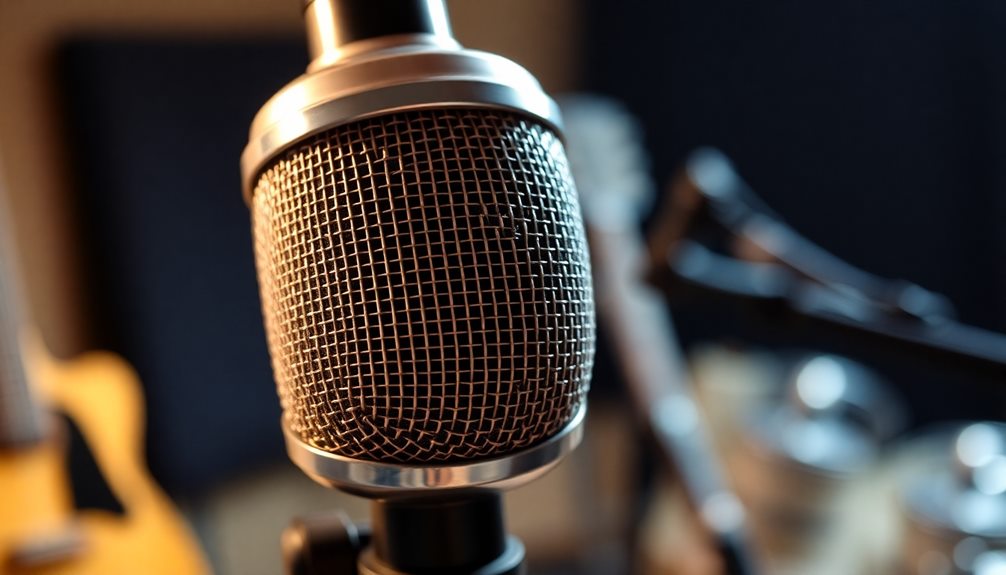
For anyone serious about audio production, the advantages of condenser microphones can't be overlooked. These mics have high sensitivity, allowing you to capture subtle audio details that other microphones might miss. This makes them perfect for studio recordings and for singing vocals.
One of the best features is their wide frequency response, which ranges from 20 Hz to 20 kHz. This helps you get accurate sound reproduction, so you can really hear the nuances in acoustic instruments and vocals.
Plus, condenser microphones have low self-noise, meaning your recordings come out clear, especially in quiet studio environments. Many condenser mics also come with an internal preamplifier, which means they can produce strong output levels without needing much gain. This makes them super easy to use in different recording situations.
Their fast transient response is another fantastic advantage. It allows you to capture sharp attacks and intricate sound details, making them the go-to choice for professional voiceovers and complex musical performances.
With all these benefits, it's clear why condenser microphones are a favorite among audio enthusiasts!
Considerations for Choosing
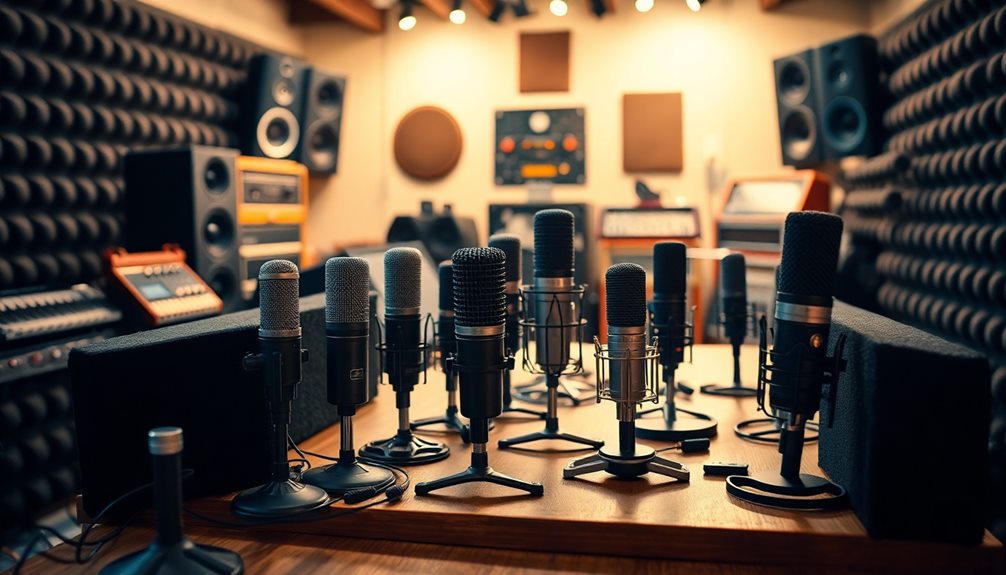
When selecting a condenser microphone, it's crucial to take into account your recording environment since these mics excel in controlled spaces with minimal background noise.
They're super sensitive, so any little sound can be picked up! Here are some things to reflect on:
- Diaphragm Size: Large-diaphragm mics are perfect for vocals, adding warmth. Small-diaphragm mics capture details well, making them great for instruments.
- Phantom Power: Most condenser microphones need phantom power, usually 48V. Make sure your audio interface or mixer provides this!
- Frequency Response: Check the frequency response you need. Condenser mics offer a wide range, making them versatile for everything from singing to strumming guitars.
- Polar Patterns: Some professional models have switchable polar patterns. This feature lets you choose how the mic picks up sound, helping you adapt to different recording situations.
Recommended Condenser Microphones
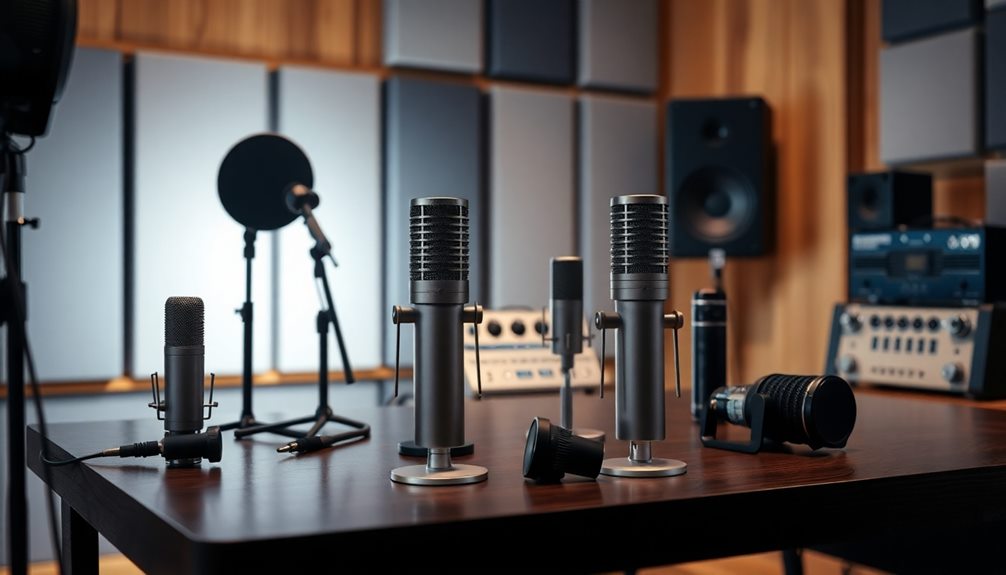
Selecting the right condenser microphone can greatly enhance your recording experience, especially with the incredible options available today. One fantastic choice is the Rode NT1. It's famous for its ultra-low self-noise level of just 4.5 dBA, making it perfect for capturing crisp vocals and detailed sound in studio recordings.
If you're a beginner, consider the Audio-Technica AT2020. It offers a frequency response of 20Hz-20kHz, providing balanced sound with good bass and clarity.
For a more professional option, check out the Neumann TLM 103. This cardioid condenser microphone is celebrated for its sonic character and wide presence boost, enhancing clarity in vocal recordings.
If you're looking for versatility, the Aston Microphones Spirit stands out with three switchable polar pickup patterns, making it ideal for different recording scenarios.
Lastly, the Slate Digital VMS ML-1 features a flat, clean response and includes eight modeled microphone options. This high-quality condenser is perfect for budget-conscious users, giving you creative possibilities in sound production.
With these recommended condenser microphones, you'll be well on your way to achieving amazing recordings!
Importance in Recording

While many factors contribute to high-quality audio, condenser microphones stand out as essential tools in the recording process. These mics are designed to capture the beauty of sound, making them a favorite in studios everywhere.
Here are some key reasons why they're so important:
- Wide Frequency Response: They can pick up sounds from 20 Hz to 20 kHz, capturing every detail of your vocals and acoustic instruments.
- Low Self-Noise: With self-noise levels as low as 4.5dBA, they capture subtle nuances that other mics might miss.
- Phantom Power: They thrive on phantom power, usually 48V, which boosts their output signal and guarantees clearer recordings.
- Versatile Polar Patterns: You can choose different polar patterns to suit your recording needs, whether you're in a studio or a cozy home setup.
Microphone Placement Tips
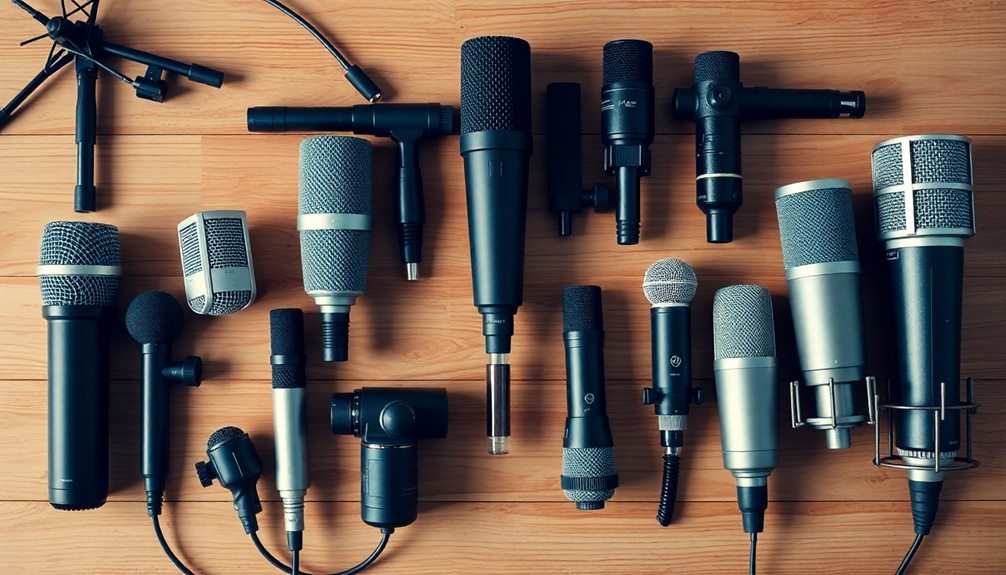
Achieving high-quality recordings with a condenser microphone also heavily relies on proper microphone placement. For vocals, position the mic about 6 inches away from the vocalist's mouth. This distance helps capture ideal clarity while reducing plosive sounds. Don't forget to use a pop filter to protect against those explosive consonants!
When recording acoustic guitars, place your microphone about 12 inches from the instrument, aimed at the 12th fret. This spot helps you capture a balanced tone with rich detail.
If you're recording drums, use condenser microphones as overheads, placing them about 3 to 4 feet above the kit. This height captures the overall sound and helps balance phase issues.
For electric guitars, get the microphone close to the speaker cabinet, usually between 1 to 3 inches away. This positioning highlights the tonal characteristics you want.
Finally, if you're in a studio, consider using multiple microphones with different placements. This technique will help you capture a more nuanced sound, making for a richer final mix.
With these microphone placement tips, you'll be on your way to creating amazing recordings! Happy recording!
Frequently Asked Questions
What Is the Best Small Diaphragm Condenser in 2024?
If you're looking for the best small diaphragm condenser in 2024, the Neumann KM 184 stands out. Its clarity, low self-noise, and versatile design make it perfect for capturing detailed sound in various settings.
What Is the Best Setup for a Condenser Mic?
To set up your condenser mic, connect it to an audio interface with phantom power, position it 6-12 inches from the source, use a pop filter, and select the right polar pattern for your environment.
What Not to Do With a Condenser Microphone?
Don't expose your condenser microphone to humidity or extreme temperatures. Avoid using it without phantom power, in noisy environments, or handling it improperly. Keep it away from sound sources to prevent distortion and plosives.
Can I Connect a Condenser Mic to My Phone?
Yes, you can connect a condenser mic to your phone, but you'll need an audio interface or adapter that provides phantom power. Alternatively, use a USB condenser mic with the right adapter for a direct connection.
Conclusion
To sum up, condenser microphones are fantastic tools for capturing sound in vivid detail. Did you know that they can pick up frequencies as high as 20 kHz? That's like hearing every little whisper of a song! Whether you're recording music, podcasts, or simply having fun, these mics bring your voice to life. Remember to think about your space and placement for the best results. With the right condenser mic, you're all set to create amazing audio experiences!
